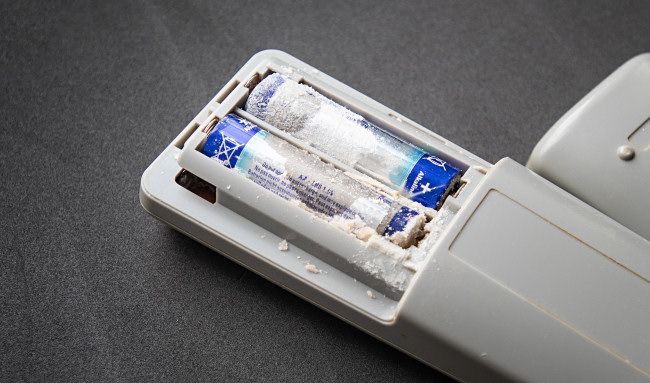It happens to the best of us: You open a gadget and see crusty white powder and sometimes metal corrosion inside. Your alkaline batteries have leaked! But why does it always happen? We'll get to the bottom of it.
Under Pressure
No matter how well a battery is designed, there's always the potential for it to start leaking because batteries are powered by active chemical reactions that don't sustain themselves forever. This is especially true for alkaline batteries, which are a common type of consumer battery used in many gadgets since the 1960s. But it can also apply to other types of batteries as well, which can swell up or burst when they begin to degrade over time.
Alkaline batteries in particular are made with a liquid electrolyte called potassium hydroxide. This chemical is very corrosive, and it can slowly eat away at the battery's casing once the battery becomes completely discharged. This creates hydrogen gas that builds pressure inside the battery itself, causing the canister that contains the chemicals to leak. As a result, the pressure will push potassium hydroxide out of the battery itself, and you have a mess on your hands.
When potassium hydroxide interacts with the air, it creates potassium carbonate, which is the white power you might see building up around a swollen or leaking battery. In some cases, leaking potassium hydroxide can also come into contact with people, causing skin and eye irritation. If this happens, thoroughly wash your hands with soap and water and rinse your eyes with clean water. Since potassium hydroxide is highly corrosive, it can also damage electronic circuitry inside the gadget, eating away at battery contacts or copper traces on a circuit board.
How to Prevent Leaking Batteries
Basically, all alkaline batteries leak eventually. But there are a few things that you can do to slow down the process and prevent the leaks from causing damage. First, you should always store unused alkaline batteries in a cool, dry place outside of any electronic devices.
Second, avoid using the same set of alkaline batteries for extended periods of time. When they wear out, the leaking will begin. And most importantly, if you know that you won't be using your batteries for a while, it's best to remove them from your devices and store them separately from the device. Even if a device is turned off, it can still draw a trickle current that will discharge the batteries over time, eventually leading to a leak that can damage the electronics inside thanks to corrosion.
How to Deal With Leaking Batteries
If you find that your alkaline batteries are leaking, there are a few things you can do to clean up the mess and prevent further damage. First, remove the batteries from your devices and clean the contact point with a cotton swab dipped in vinegar or lemon juice. This will help neutralize the alkaline potassium hydroxide, which is a base (not an acid). Also, use an old but clean toothbrush with soft bristles to gently brush off any white powder into a trash bag.
Then place the batteries inside a sealed container and dispose of the batteries properly at a local recycling center. When you're all done, make sure you wash your hands thoroughly with soap and water. Stay safe out there!


